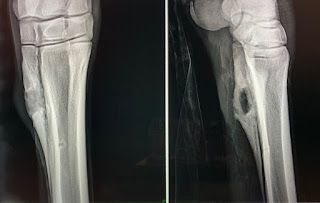Here are some of the medical cases we saw this week:
Pituitary Pars Intermedia Dysfunction (PPID) + Maggots!
PPID is also known as Equine Cushing’s Disease. It involves an overgrowth of a portion of the pituitary gland (pars intermedia!) which leads to an excess production of hormones. PPID is most commonly seen in older horses and has been associated with a gradual onset of laminitis in about half of all cases. Repeated infections such as sole abscesses have additionally been associated with PPID, thus, enter the maggots. Medical-grade (don’t try this at home!) maggots were placed in pockets of the hoof where they are meant to chomp away at dead and infected tissues, while leaving the healthy tissue alone. The maggots will be allowed to feast for a couple of days, kept in place through the use of bandage material.
Choke + NG tube
Choke is the term used to describe an esophageal obstruction, usually caused by food. When the cause is food, the most common culprits are food that is too dry or coarse and food that swells in size once moistened ex. sugar beet. Often you will see saliva and feed material coming out of the horse’s nose and/or mouth. A scope was passed through one nostril to identify the location of the feed while a nasogastric (NG) tube was then passed through the other nostril in order to try and flush the material out. Water was pumped through the tube into the esophagus and then a mixture of gravity and pressure forces were used to allow the material to flow back out of the horse.
Case Highlight: Splint bone osteolysis
A horse presented to us with a swelling around the area of it’s splint bone. Radiographs were taken and they revealed osteolysis within one of the splint bones. The suspected cause was some sort of trauma that could have led to an infection. The horse was taken to surgery, and the area was debrided.
The splint bones deserve more credit than at first given to them! When dealing with injuries to the splint bones, you have to remember that the heads of the splint bones come into contact with the horse’s wrists and hocks and thus help stabilize those structures. In addition, callus formation on the splint’s can lead to impingement on the suspensory ligament.
It’s getting hot and humid here in NJ! Summer and relentless fly’s are upon us. Until next week!

No comments:
Post a Comment